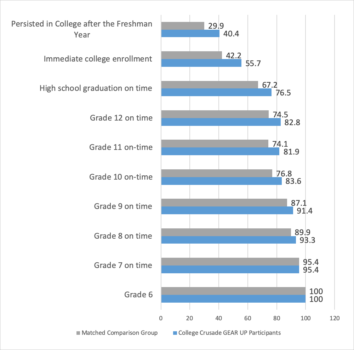 The federally financed GEAR UP (Gaining Early Awareness and Readiness for Undergraduate Program) was organized two decades ago with the purpose of increasing high school completion and college enrollment among low-income students. The College Crusade of Rhode Island’s GEAR UP program was designed as a long-term effort to buttress student success by providing various kinds of educational and social service supports beginning in the sixth grade and continuing through high school completion.
The federally financed GEAR UP (Gaining Early Awareness and Readiness for Undergraduate Program) was organized two decades ago with the purpose of increasing high school completion and college enrollment among low-income students. The College Crusade of Rhode Island’s GEAR UP program was designed as a long-term effort to buttress student success by providing various kinds of educational and social service supports beginning in the sixth grade and continuing through high school completion.
Back in 2015, the authors completed the first study in the nation that measured the net impact study of a GEAR UP program. That study track a cohort of entering sixth-graders who participated in the College Crusade GEAR UP program relative to a comparison group selected with the rigorous Propensity Score Matching (PSM) method that creates a comparison group with traits equivalent to the participant group at the time of sixth grade entry into the program. This baseline equivalency at the time of program entry means that differences in outcomes that occur between the participant and matched comparison groups are attributable to participation in the GEAR UP program.
That longitudinal impact study found substantial and statistically significant gains for a single cohort of GEAR UP program participants relative to the comparison group on the likelihood of completing high school on time and immediately enrolling in college in the fall following high school completion, providing evidence that the College Crusade of Rhode Island was able to substantially improve these two important educational outcomes of GEAR UP participants.
While high school completion and college enrollment have remained high priorities for the nation’s education system, in recent years, much greater attention has been focused on college retention and completion. This raises the question about the lasting effects of participation in the College Crusade’s GEAR UP program. Do the gains that the program provided in the sixth through 12th grades persist for participants once enrolled in college? At the time that these cohorts of students were participating in the College Crusade GEAR UP program, participants who were enrolled in college did not receive any systematic support from the College Crusade. This created the opportunity for us to examine whether the sizeable impacts of GEAR UP participation in middle school and high school persist beyond high school completion and immediate college enrollment or do they fade out after entry into college.
Enough time has now elapsed for three cohorts of College Crusade GEAR UP participants to have completed their first year of college, providing an opportunity to measure the impact of participation in the College Crusade GEAR UP program beyond initial college enrollment.
The effects of participation in the College Crusade GEAR UP program are cumulative; that is, we found that the program was able to increase the likelihood of on-time grade attainment for participants relative to the matched comparison group for each year after initial enrollment in the sixth grade. The cumulative effects of these positive outcomes in each successive year for participants relative to comparison group students become quite sizable as students progress from middle school to college.
The chart below illustrates the divergent educational pathways of College Crusade participants and their matched comparison group counterparts. Beginning in the eighth grade, a gap emerges between participants and comparison group students in the likelihood of staying on track; and the size of this gap continues to grow in each successive grade/year. By the time of high school graduation, the gap had grown to 9.3 percentage points in favor of GEAR UP participants; 77% of the three cohorts of participating students had graduated from high school on time compared with just 67% of their counterparts in the matched comparison group. During the fall term following their expected on-time high school graduation, 56% of the three sixth grade participant cohorts had enrolled in college, compared with 42% of the three 6th grade comparison group cohorts.
Eight years after the beginning of sixth grade when these three cohorts of participants had enrolled in the College Crusade GEAR UP program, 40% had returned to college after the freshman year, relative to 30% among their matched comparison group counterparts.
This means that the cumulative impact of the College Crusade’s GEAR UP program was to increase the relative likelihood of a low-income sixth grader in Rhode Island to progress through middle and high school and complete a year of college by 35%.
The Pathway from Sixth Grade to One Year of College Retention, Combined Sixth Grade Cohorts, 2007-08, 2008-09 and 2009-10
These findings reveal that the College Crusade’s GEAR UP program had a cumulative effect that reached beyond its formal goals of high school completion and college enrollment. The cumulative gains for participants relative to the comparison group increased each year though high school graduation and college entry. Beyond that, despite no formal GEAR UP services for participants once enrolled in college, the gains to their earlier participation in the program continued. No evidence of a fade out of the substantial positive effects of GEAR UP participation is found one year after participants had exited the program.
The first year results are promising, but the kinds of obstacles to degree attainment that low-income college students confront are associated with complex academic, social and financial issues that are somewhat different from the barriers that these students face in completing high school and initially enrolling in college. Will these cumulative one-year college retention gains persist through college completion with no fade out effects? Stay tuned.
Neeta Fogg is research professor at the Center for Labor Markets and Policy at Drexel University. Paul Harrington is director of the center. Ishwar Khatiwada is an economist there.
[ssba]

